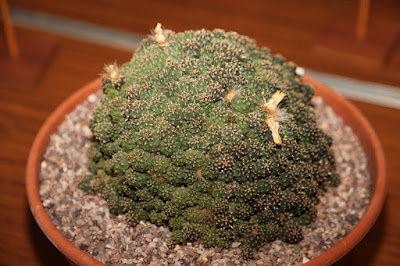Puna subterranea is found from Jujuy in Argentina and Potosí in Bolivia at elevations from 3000 to 4000 m above sea level.. This geophytic cactus grows on sandy and rocky soils at high altitudes in puna. It is very small and difficult to find, given that it grows almost underground...
Puna subterranea also called as Maihueniopsis subterranea, Opuntia subterranea, Pseudotephrocactus subterraneus, Tephrocactus pulcherrimus, Tephrocactus subterraneus, Tephrocactus variiflorus, is a species of the genus Puna. This species was described by R. Kiesling in 1982.
IDENTIFY PUNA SUBTERRANEA
Puna subterranea is found from Jujuy in Argentina and Potosí in Bolivia at elevations from 3000 to 4000 m above sea level.. This geophytic cactus grows on sandy and rocky soils at high altitudes in puna. It is very small and difficult to find, given that it grows almost underground.
It is a geophytic, terrestrial, small sized cactus with a tuberous root, half submerged in the ground, with grayish-green to brownish, round in section, elongated, up to 6 cm in width, but usually smaller, 15-18 mm. in diameter and 2-4 cm in height stem. The 1-7, sometimes up to ten spines are pectinate (combed), more or less pressed to the body of the cactus. The leaves are very small and fall quickly.
This cactus blooms in the daytime in summer with 2.5-3 cm in length flowers. The color of the flowers are very diverse, sometimes it seems that each specimen has its own shade: from brown to dark pink, from red to yellowish pink, occasionally you can see white flowers. It produces spherical, 12-15 mm in diameter, dry, not opening fruits and 4 mm long, covered with a delicate skin seeds.
PUNA SUBTERRANEA CARE AND CULTURE
Cultural information should only be used as a guide, and should be to be adapted to suit you. Your physical location; where you grow your plants, how much time you have to devote to their care, and many other factors, will need to be taken into account. Only then can you decide on the cultural methods that best suit you and your plants.
Light:
Substrate, growing media and repotting:
It is a mountain cactus with a long thick turnip root, so you need to use a deep pot with a well-drained mineral soil mix.
Watering:
This cactus is sensitive to overflow, but during the growing season it needs to be given a sufficient amount of water.
Rest period:
Wintering should be cold and dry. With a dry content, this cactus tolerates low temperatures well. The winter rest period is necessary for the flowering and health of the cactus, without this period the little bud is formed.
Grow from seeds:
Cactus seedlings are very fragile on the first weeks and survival depends on how they are treated on that crucial stage; out of 100 of seeds in the wild only a few survive to an adult plant to produce seeds and start the cycle again. Obtaining a high percentage of adult plants from a batch of seedlings, depends on how each collector takes care of their seedlings.
Water for seedlings is the most important item to keep them growing for first few weeks. Generally, most seedlings, which are 1 week old will die after 3 days of dryness. 2 month-old seedlings can survive for 1 week if allowed to dry. 6 month-old seedlings can survive for 2 months if allowed to dry. 1 year-old seedlings can survive for 5 months if allowed to dry.
Planting instructions for 4”pot kit: First, clean with water and chlorine plastic pot, clear cover and label and wash with fresh water. Second, the soil can be sterilized for 2 hours at 120º C in an oven or a microwave but can be used without sterilization. Third, fill the pot with soil and spray with distilled, reverse osmosis or pure rainwater to let soil flatten at the top. Fourth, place to 1/8 to 1/4 inch layer of Dyna Rock or crushed sea shell extra fine on top to cover the soil making a layer between soil and seeds. Fifth, place seeds over the Dyna Rock and fine spray water the seeds well and cover with a clearcover.















COMMENTS